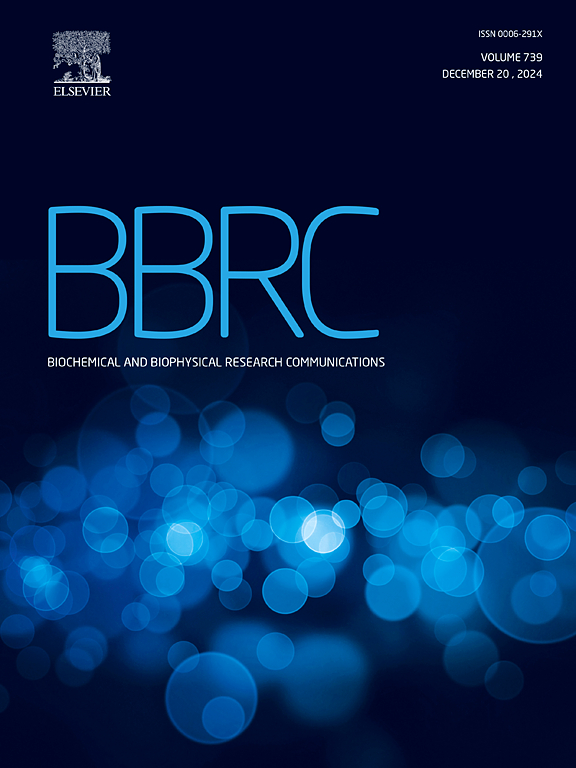Pre-ribosomal WDR74 module coordinates the early and late pre-rRNA processing stages for the NVL2-mediated regulation of 60S ribosome biogenesis
IF 2.5
3区 生物学
Q3 BIOCHEMISTRY & MOLECULAR BIOLOGY
Biochemical and biophysical research communications
Pub Date : 2025-01-01
DOI:10.1016/j.bbrc.2024.151175
引用次数: 0
Abstract
WD repeat domain 74 (WDR74) is a nucleolar protein involved in the early stages of pre-60S maturation in the ribosome biogenesis pathway. In later stages, WDR74 interacts with MTR4, an RNA helicase that functions with the exosome nuclease complex, and is dissociated upon ATP hydrolysis by the chaperone-like nuclear VCP-like 2 (NVL2) AAA-ATPase. We previously reported that ATP hydrolysis-defective NVL2 causes aberrant accumulation of WDR74 on the MTR4–exosome complex at the nucleolar periphery and in the nucleoplasm and that this nuclear redistribution of WDR74 leads to the unusual cleavage of the early rRNA precursor within the internal transcribed spacer 1 sequence. However, the precise mechanisms underlying this NVL2-mediated regulation is largely obscure. In this study, co-immunoprecipitation combined with mass spectrometry revealed that WDR74 functions as part of a pre-ribosomal subcomplex, termed the WDR74 module, consisting of eukaryotic conserved WDR74, RPF1, MAK16, and RRP1. Each component of the WDR74 module was mutually essential for the interaction of other members with MTR4, and all components were required for the accurate cleavage of pre-rRNA during 60S ribosome biogenesis. Moreover, impaired release of WDR74 from the MTR4–exosome complex caused by NVL2 dysfunction prevented MTR4 from recruiting PICT1, an MTR4 adaptor protein required for the 3′-end maturation of 5.8S rRNA. Our results highlight the key role of the WDR74 module in coordinating the early pre-rRNA cleavage and late processing of pre-5.8S rRNAs.

前核糖体WDR74模块协调nnvl2介导的60S核糖体生物发生调控的早期和晚期前rrna加工阶段。
WD重复结构域74 (WDR74)是核糖体生物发生途径中参与60s前成熟早期阶段的核核蛋白。在后期阶段,WDR74与MTR4相互作用,MTR4是一种与外泌体核酸酶复合物一起起作用的RNA解旋酶,并在ATP水解时被伴侣样核VCP-like 2 (NVL2) aaa -ATP酶解离。我们之前报道过ATP水解缺陷的nnvl2导致WDR74在核核周围和核质的mtr4外泌体复合体上的异常积累,并且WDR74的核重分配导致内部转录间隔1序列内早期rRNA前体的异常切割。然而,这种nvl2介导的调控的确切机制在很大程度上是模糊的。在这项研究中,共免疫沉淀结合质谱法发现WDR74作为核糖体前亚复合物的一部分起作用,称为WDR74模块,由真核保守的WDR74、RPF1、MAK16和RRP1组成。WDR74模块的每个组件对于其他成员与MTR4的相互作用都是必不可少的,并且在60S核糖体生物发生过程中,所有组件都是精确切割pre-rRNA所必需的。此外,nnvl2功能障碍导致MTR4-外泌体复合物释放WDR74受损,阻止了MTR4募集PICT1, PICT1是5.8S rRNA 3'端成熟所需的MTR4接头蛋白。我们的研究结果强调了WDR74模块在协调pre-rRNA早期切割和pre-5.8S rrna后期加工中的关键作用。
本文章由计算机程序翻译,如有差异,请以英文原文为准。
求助全文
约1分钟内获得全文
求助全文
来源期刊
CiteScore
6.10
自引率
0.00%
发文量
1400
审稿时长
14 days
期刊介绍:
Biochemical and Biophysical Research Communications is the premier international journal devoted to the very rapid dissemination of timely and significant experimental results in diverse fields of biological research. The development of the "Breakthroughs and Views" section brings the minireview format to the journal, and issues often contain collections of special interest manuscripts. BBRC is published weekly (52 issues/year).Research Areas now include: Biochemistry; biophysics; cell biology; developmental biology; immunology
; molecular biology; neurobiology; plant biology and proteomics

 求助内容:
求助内容: 应助结果提醒方式:
应助结果提醒方式:


